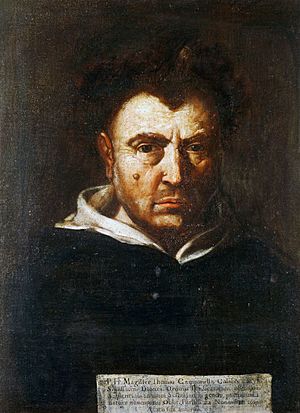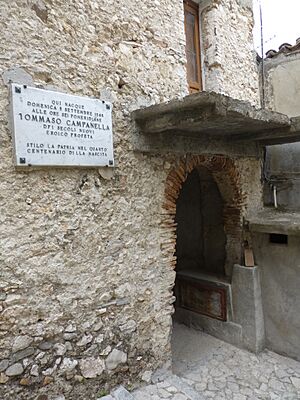Tommaso Campanella facts for kids
Quick facts for kids
Tommaso Campanella
|
|
|---|---|
 |
|
| Born | 5 September 1568 Stignano, Calabria, Kingdom of Naples
|
| Died | 21 May 1639 (aged 70) Paris, Kingdom of France
|
| Occupation |
|
| Years active | 1597–1634 |
Tommaso Campanella (born September 5, 1568 – died May 21, 1639) was an Italian Dominican friar, philosopher, and poet. His full name at birth was Giovanni Domenico Campanella. He was also interested in astrology and theology.
Campanella faced challenges because of his ideas. In 1594, the Roman Inquisition (a church court) investigated him for his beliefs. He was kept under house arrest for two years. Later, in 1599, he was accused of planning against the Spanish rulers in Calabria. He was put in prison, where he stayed for 27 years.
During his time in prison, he wrote many important books. One of his most famous works is The City of the Sun. This book describes a perfect, imaginary society where everyone is equal and shares everything.
Contents
About Tommaso Campanella
Tommaso Campanella was born in 1568 in a poor family in Stilo, southern Italy. He was a very smart child, even though his father was a shoemaker who couldn't read. Before he was 14 years old, he joined the Dominican Order. He chose the name "fra' Tommaso" to honor Thomas Aquinas, a famous philosopher. He studied theology and philosophy deeply.
His Early Ideas
Campanella soon disagreed with the common teachings of Aristotle. He was more interested in the ideas of Bernardino Telesio. Telesio believed that we learn through our senses and that everything in nature can feel things. Campanella wrote his first book, Philosophia sensibus demonstrata, in 1592 to support Telesio's ideas.
In 1590, he began studying astrology in Naples. Astrology, which is the study of how stars and planets might affect human events, became a big part of his writings.
Challenges with the Church
Campanella's different views, especially his disagreement with Aristotle, caused problems with church leaders. In 1594, he was arrested in Padua and brought before the Holy Office in Rome. He was kept in a convent until 1597.
After being set free, Campanella went back to Calabria. There, he was accused of leading a plan against the Spanish rulers in his hometown of Stilo. Campanella wanted to create a society where people shared everything. He believed a new "Age of the Spirit" would begin in the year 1600.
However, two people involved in his plan betrayed him. He was captured in 1599 and put in prison in Naples. He spent 27 years in different prisons there. Even while imprisoned, he kept in touch with other thinkers and artists through letters.
Writing in Prison
During his long imprisonment, Campanella wrote many of his most important books. These include:
- The Monarchy of Spain (1600)
- Political Aphorisms (1601)
- Atheismus triumphatus (Atheism Conquered, 1605–1607)
- Metafisica (1609–1623)
- Theologia (1613–1624)
- His most famous work, The City of the Sun (written in 1602, published in Latin in 1623).
He also supported Galileo Galilei during Galileo's first trial. Campanella wrote a book called The Defense of Galileo in 1616. He even wrote to Galileo in 1632, offering advice and support.
Freedom and Later Life
In 1626, Campanella was finally released from prison. Pope Urban VIII helped him get free. The Pope brought Campanella to Rome and later gave him full freedom in 1629. The Pope needed Campanella's knowledge of astrology to help him with upcoming eclipses. Campanella used his skills to perform "natural magic" to protect the Pope.
Campanella's methods seemed to work, and the Pope survived. In return, Campanella was allowed to teach his ideas in Rome. He lived in Rome for five years, advising the Pope on astrological matters.
In 1634, a new conspiracy in Calabria, led by one of his followers, caused more trouble for Campanella. With help from powerful friends, he escaped to France. There, he was welcomed by King Louis XIII and given support by Cardinal Richelieu. He spent the rest of his life in a convent in Paris. His last work was a poem celebrating the birth of the future King Louis XIV.
Historian John Headley described Campanella as someone who tried to change the world. He wanted to fight against what he saw as unfair rule, false ideas, and dishonesty.
Main Works
- Philosophia sensibus demonstrata, 1591
- Monarchia Messiae, 1605
- Prodromus philosophiae instaurandae, 1617
- La città del sole (The City of the Sun), 1602 (Latin Civitas solis, 1623)
- Atheismus triumphatus, 1631
Images for kids
See also
 In Spanish: Tommaso Campanella para niños
In Spanish: Tommaso Campanella para niños
- Utopian and dystopian fiction
- Millennialism






